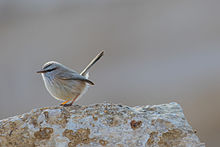
Leaf warblers are small insectivorous passerine birds belonging to the genus Phylloscopus.

The family Cisticolidae is a group of about 160 warblers, small passerine birds found mainly in warmer southern regions of the Old World. They were formerly included within the Old World warbler family Sylviidae.

Sykes's warbler is an Old World warbler in the tree warbler family. It was formerly considered a subspecies of the booted warbler, but is now considered a full species. Its breeding range is from northeast Arabia to Turkestan, west China and Afghanistan. Like the booted warbler, many populations of the species migrate in winter to the Indian subcontinent as far south as Sri Lanka.

Philipp Jakob Cretzschmar was a German physician and natural scientist.
The pale-footed bush warbler is a species of oriental warbler in the family Cettiidae that is found in southern Asia. It occurs in the Himalayan region west from Dehradun through the foothills of Nepal to northeastern India. It also occurs in Myanmar, Laos, northern Vietnam and southern China. A single sighting was recorded from Kandy, Sri Lanka in March 1993.

Passerida is, under the Sibley-Ahlquist taxonomy, one of two parvorders contained within the suborder Passeri. While more recent research suggests that its sister parvorder, Corvida, is not a monophyletic grouping, the Passerida as a distinct clade are widely accepted.

The Cape grassbird or Cape grass warbler is an African warbler found in southern Africa. It is the only species placed in the genus Sphenoeacus.

The eremomelas are a genus, Eremomela, of passerines in the cisticola family Cisticolidae. The genus was previously placed with the larger Old World warbler family Sylviidae prior to that genus being broken up into several families. The genus contains eleven species, all of which are found in sub-Saharan Africa. They occupy a range of habitats, from arid scrub to lowland tropical forest. They are intermediate in appearance between crombecs and apalis, and measure between 8.5 to 12 cm (3.3–4.7 in) in length. The sexes are alike in size and plumage.

Hemitesia is a genus of Old World warblers in the family Cettiidae, formerly classified in the family Sylviidae. The genus was erected by James Chapin in 1948.

The chestnut-headed tesia is a small insectivorous songbird formerly of the "Old World warbler" family but nowadays placed in the bush warbler family (Cettiidae).

The tesias are a genus, Tesia, of Old World warbler. Though once included in the large family Sylviidae, more recent research placed it within a new family, Cettiidae. The four species inhabit undergrowth of montane forest in South and Southeast Asia, where they are resident or short-range migrants. They have longish legs and appear tailless, with (seemingly) only 8 rectrices. Their simple songs are fairly loud, and their nests are typically ball-shaped. Their name is derived from Tisi, the Nepalese name for the grey-bellied tesia.

The Bornean stubtail is a species of bird in the cettiid warbler family Cettiidae. It is endemic to the island of Borneo, where it inhabits forest floors and undergrowth in montane forests at elevations of 750–3,150 m (2,460–10,330 ft). It is a small, short-tailed warbler, measuring 9.5–10 cm (3.7–3.9 in) in length and having an average mass of 10.4 g (0.37 oz). The tops of the head and the upperparts are brown, with whitish underparts that turn grey at the sides of the breast and the flanks. The supercilium is long and buffish-brown, with an equally long dark grey eyestripe and a thin yellow eye-ring. Both sexes are similar.

Cettiidae is a newly validated family of small insectivorous songbirds ("warblers"), formerly placed in the Old World warbler "wastebin" assemblage. It contains the typical bush warblers (Cettia) and their relatives. As a common name, cettiid warblers is usually used.

Camaroptera is a genus of small passerine birds in the family Cisticolidae that are found in sub-Saharan Africa.

Erythrocercus is a genus of birds containing three flycatchers that are found in Africa.

Pnoepyga is a genus of passerines endemic to southern and southeastern Asia. Its members are known as cupwings or wren-babblers. The genus contains four species. The genus has long been placed in the babbler family Timaliidae. A 2009 study of the DNA of the families Timaliidae and the Old World warblers (Sylviidae) found no support for the placement of the genus in either family, prompting the authors to erect a new monogeneric family, the Pnoepygidae.

Sylvioidea is a superfamily of passerine birds, one of at least three major clades within the Passerida along with the Muscicapoidea and Passeroidea. It contains about 1300 species including the Old World warblers, Old World babblers, swallows, larks and bulbuls. Members of the clade are found worldwide, but fewer species are present in the Americas.

The African warblers are a newly erected family Macrosphenidae, of African songbirds. Most of the species were formerly placed in the Old World warbler family Sylviidae, although one species, the rockrunner, was placed in the babbler family, Timaliidae. A series of molecular studies of the Old World warblers and other bird families in the superfamily Sylvioidea found that the African warblers were not part of Sylviidae but were instead an early (basal) offshoot of the entire clade Sylvioidea. Some taxonomic authorities place the entire family Hyliidae here.

The species of tailorbirds listed below are small birds of the genus Phyllergates . They were previously placed in the Old World warbler family Sylviidae. However, recent research suggests they more likely belong in the Cettiidae.

Hyliidae is a family of passerine birds which contains just two species, the green hylia and the tit hylia. Physiological similarities and molecular phylogenetic studies strongly support the creation of this family.























